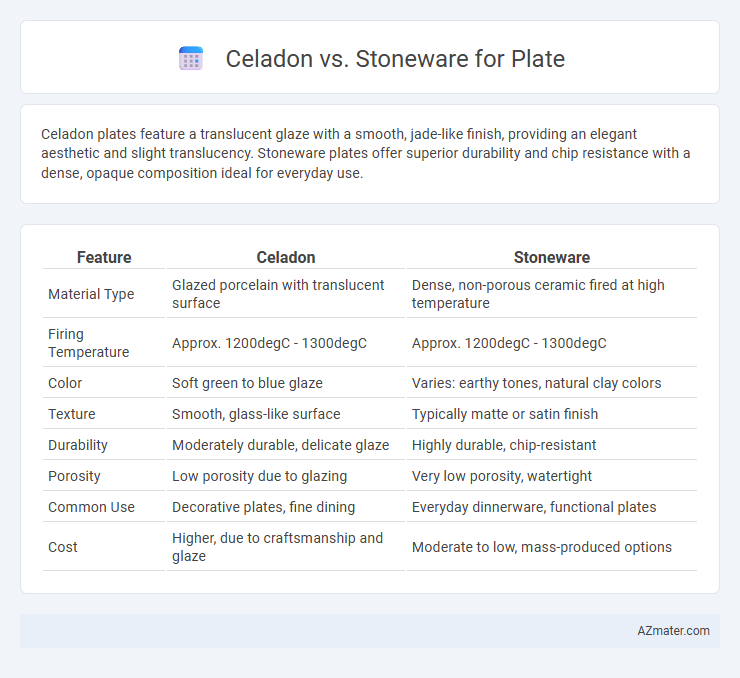Celadon plates feature a translucent glaze with a smooth, jade-like finish, providing an elegant aesthetic and slight translucency. Stoneware plates offer superior durability and chip resistance with a dense, opaque composition ideal for everyday use.
Table of Comparison
| Feature | Celadon | Stoneware |
|---|---|---|
| Material Type | Glazed porcelain with translucent surface | Dense, non-porous ceramic fired at high temperature |
| Firing Temperature | Approx. 1200degC - 1300degC | Approx. 1200degC - 1300degC |
| Color | Soft green to blue glaze | Varies: earthy tones, natural clay colors |
| Texture | Smooth, glass-like surface | Typically matte or satin finish |
| Durability | Moderately durable, delicate glaze | Highly durable, chip-resistant |
| Porosity | Low porosity due to glazing | Very low porosity, watertight |
| Common Use | Decorative plates, fine dining | Everyday dinnerware, functional plates |
| Cost | Higher, due to craftsmanship and glaze | Moderate to low, mass-produced options |
Introduction to Celadon and Stoneware Plates
Celadon plates showcase a translucent, pale green glaze derived from iron oxide, epitomizing traditional East Asian ceramics celebrated for their smooth, glass-like finish and subtle crackle patterns. Stoneware plates, made from dense clay fired at high temperatures between 1,200degC and 1,300degC, offer exceptional durability and non-porous surfaces ideal for everyday use. Both ceramic types balance aesthetics and functionality, with celadon prized for its elegance and stoneware favored for its robustness.
Historical Background of Celadon and Stoneware
Celadon ceramics originated in ancient China during the Eastern Han Dynasty, characterized by their distinctive jade-like green glaze achieved through iron oxide in a reduction kiln firing. Stoneware dates back to the Shang Dynasty and is notable for its high-fired, non-porous durability, often unglazed or finished with simple glazes. Both celadon and stoneware played significant roles in East Asian pottery traditions, influencing global ceramic techniques and artistry.
Materials and Composition Comparison
Celadon plates are crafted from porcelain clay that undergoes high-temperature glazing, resulting in a translucent, jade-like finish with a smooth texture. Stoneware plates utilize denser, non-porous clay fired at lower temperatures, producing a heavier, more durable body with an opaque, earthy appearance. The key difference lies in celadon's glazed, delicate porcelain composition versus stoneware's robust, coarse ceramic material.
Manufacturing Processes: Celadon vs Stoneware
Celadon plates are crafted through a high-temperature firing process with a translucent glaze that reacts chemically with iron oxide in the clay, creating their signature jade-like finish. Stoneware plates undergo firing at temperatures typically between 1,100degC and 1,300degC, resulting in a dense, non-porous body without the glassy surface seen in celadon. The key manufacturing difference lies in celadon's specific reduction firing technique, which requires precise atmospheric control, whereas stoneware can be produced using more standard oxidation or reduction firings.
Appearance and Aesthetic Differences
Celadon plates showcase a translucent glaze with subtle green or blue hues, creating an elegant and smooth surface that enhances delicate patterns beneath. Stoneware plates feature a denser, opaque finish with earthy tones and a more rustic texture, often revealing natural clay variations. The glossy, refined look of celadon contrasts with the matte or satin finish of stoneware, catering to different aesthetic preferences in tableware design.
Durability and Strength: Which Is Better?
Stoneware plates generally offer superior durability and strength compared to celadon due to their dense, non-porous composition and high firing temperatures, which make them resistant to chipping and cracking. Celadon, known for its translucent glaze and aesthetic appeal, tends to be less robust, often more prone to damage under heavy use. For everyday use where durability is critical, stoneware is the preferred choice, while celadon suits decorative or light-use settings better.
Functional Uses: Everyday vs Special Occasions
Celadon plates offer a smooth, glazed surface ideal for serving both everyday meals and special occasions, combining aesthetic appeal with practical durability. Stoneware plates provide robust strength and chip resistance, making them highly suitable for daily use and casual dining environments. While celadon's translucent glaze adds elegance suited for formal settings, stoneware's heavier, rustic feel emphasizes functionality and sturdiness for routine use.
Maintenance and Care Requirements
Celadon plates, known for their delicate glaze and subtle translucency, require gentle hand washing with mild detergents to avoid damaging the finish and avoid sudden temperature changes that can cause cracking. Stoneware plates offer greater durability and resistance to chipping, allowing for dishwasher and microwave use without compromising structural integrity. Proper maintenance of celadon ensures longevity of its aesthetic qualities, while stoneware's robustness makes it suitable for everyday use with minimal care.
Cost and Value Analysis
Celadon plates typically cost more due to their intricate glazing process and historical significance, while stoneware plates are generally more affordable and durable for everyday use. The value of celadon lies in its aesthetic appeal and collectible nature, often increasing over time, whereas stoneware offers practicality and longevity, making it a cost-effective choice for frequent dining. Consumers prioritizing elegance may invest in celadon despite higher costs, while those seeking affordability and strength favor stoneware for long-term utility.
Choosing the Right Plate: Celadon or Stoneware
Celadon plates offer a smooth, translucent glaze with subtle greenish hues, making them ideal for elegant dining settings and delicate presentations. Stoneware plates provide exceptional durability and a rustic, earthy appearance, perfect for everyday use and casual meals. Selecting the right plate depends on balancing aesthetic appeal with practical considerations like frequency of use and resistance to chipping.

Infographic: Celadon vs Stoneware for Plate
 azmater.com
azmater.com